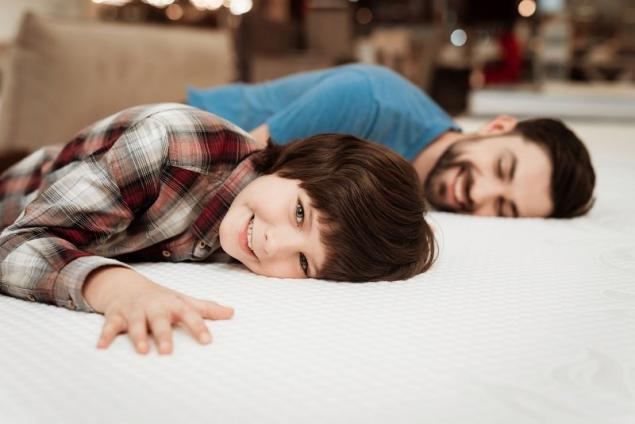199
How to choose a mattress
It is no secret that a good sleep depends on many factors, not least the mattress. But an unambiguous answer to the question, Which mattress is best for sleeping?But experts can't give it.

Everything individually and the greatest benefit to you will bring the mattress on which it is most comfortable to lie. Therefore, even ardent fans of online shopping we advise to get to the store and personally compare different types of mattresses.

If you don’t have your favorite mattress yet, you need to find it. We spend a third of our lives sleeping, so we need to make choices responsibly. "Site" It will tell you what signs to pay attention to.
By the way, the word “orthopedic” in the name of the mattress was invented solely for marketing purposes. In accordance with the federal law “On advertising” dated 01.10.2015, it is impossible to use the word “orthopedic” in the name of mattresses, because they are not medical devices and are not intended for the treatment of diseases, but only to maintain the spine in its natural position and ensure comfort during sleep.

Which mattress to choose
There are many types of fillers for mattresses. Almost all of them are used in both springless and spring mattresses. Most often you can find a combination of several materials.
The stiffness of the mattress is selected individually depending on the age, weight and taste of the person. The greater the weight of the sleeper, the tougher the mattress should be.

Dimensions of mattress
The length of the mattress for adults is chosen by the formula: human height + 10-20 centimeters. Standard mattresses for adults are 190 and 200 centimeters long. The width of the mattress is chosen depending on the size of the bed and the number of people who will sleep on the bed.
Checklist of mattress buyer
We hope that this article helped you decide on the choice of a mattress or at least made you think about the need to change your old crushed mattress to a new, corresponding to age and health.
And new mattress could serve faith and truth for more than 20 years, do not forget to turn it over every three months, and every six months - change the position of "legs - head". So the soft layers of the mattress will be evenly threaded.
The mattress can be vacuumed, which greatly facilitates the cleaning process and helps reduce the population of dust mites to a safe level. At least once a month, ventilate it with open windows without bedding and mattress.

Everything individually and the greatest benefit to you will bring the mattress on which it is most comfortable to lie. Therefore, even ardent fans of online shopping we advise to get to the store and personally compare different types of mattresses.

If you don’t have your favorite mattress yet, you need to find it. We spend a third of our lives sleeping, so we need to make choices responsibly. "Site" It will tell you what signs to pay attention to.
By the way, the word “orthopedic” in the name of the mattress was invented solely for marketing purposes. In accordance with the federal law “On advertising” dated 01.10.2015, it is impossible to use the word “orthopedic” in the name of mattresses, because they are not medical devices and are not intended for the treatment of diseases, but only to maintain the spine in its natural position and ensure comfort during sleep.

Which mattress to choose
- Spring mattresses
Classic spring mattresses for more than 100 years produced on the basis of spring blocks Bonnel. Springs in the form of an hourglass in them are connected to each other in a single canvas. Pushed on one, everyone moved.
The main advantage of the Bonnel mechanism is its low cost. Such mattresses have almost no orthopedic effect, there is also a high chance that over time they will begin to creak. The spring block can break, the sharp edges of the springs can pierce the upholstery of the mattress or prick through it. - Mattresses with independent springs
In such mattresses, each spring is in a separate cover and does not contact neighboring ones. This avoids the hammock effect characteristic of Bonnel systems. The role of intermediaries between the spring block and the surface of the mattress is performed by latex, orthopedic foam felt and other materials, the characteristics of which directly affect the parameters of the product.
Mattresses with a spring block differ in the number of springs. The best option is the density of 1000-2000 pieces per bed (1 x 2 meters). The greater the number of springs, the stronger the design. Modern mattresses are usually made with a density of 256, 500 and 1000 springs per square meter.
- Springless mattresses
The main thing in springless mattresses is the filler. All springless mattresses are divided into monolithic or combined, depending on whether they use one layer of filler or several.
In monoliths, latex, blocks of coconut fibers and polyurethane foam are most often used. In combined mattresses, layers of fillers are interspersed. As a rule, tougher materials alternate with soft ones.
Rigidity is provided by such materials as coconut cairn, sisal, abaca. Combined models have a high level of comfort and a long service life. Some mattresses of this type do not have load restrictions. - Mattresses with shape memory
In 1966, NASA successfully completed a project to develop a material that would make it easier for astronauts to carry overloads during launch. The result was a foamed polymer that can quickly and accurately adapt to the human figure and was called memory foam.
Thanks to the ability of memory foam viscosity absorb body pressure, mattresses based on it have become a real hit, consistently leading in consumer surveys. Regardless of the person’s posture during sleep, viscoelastic foam delicately minimizes pressure on the spine and joints. - Bilateral, unilateral and versatile mattresses
Most mattresses are one-sided, but some companies specializing in the production of orthopedic mattresses offer two-way models. On the one hand, versatile mattresses can be of medium stiffness, and on the other hand - hard or soft and therefore suitable for those who like to sleep either hard or soft. - Winter-summer mattresses
Seasonal mattresses are a real find for lovers of summer coolness and winter warmth. Such products have different surface characteristics that can be used depending on the time of year.
The effect of “winter – summer” is achieved due to the fact that on one side of the mattress a layer of cotton is laid, and on the other wool. Cotton easily passes air, contributing to its excellent circulation and thereby preventing sweating during sleep. The side on which the cotton layer is laid is summer.
Wool, on the contrary, stores the heat of the human body, which is released during sleep, and thereby provides a warming effect. This side of the mattress is called winter, or with the effect of winter.
In order not to confuse the sides of the product, they are marked with special designations or shades of flaps. This can be an image of the sun or snowflakes, sewn pieces of fabric pink or blue. - Topper mattresses
In addition to the usual lush mattresses, whose height can reach several tens of centimeters, buyers often look for toppers and futons – thin mattresses that are usually used as an addition to an already equipped bed.
The futons that came to us from Japan were traditionally filled with cotton. Today, futons are filled not only with natural, but also artificial materials. Toppers can have one or more fillers. The height of such mattresses can reach 9 cm.
Topper mattresses are most often easily folded and therefore can be transported without problems. Such products are simply indispensable in nature or in places not too suitable for overnight stay.
There are many types of fillers for mattresses. Almost all of them are used in both springless and spring mattresses. Most often you can find a combination of several materials.
- wata
Cotton wool consists of 100% cotton (fragmented). It's a natural, environmentally friendly material. It is often used in winter-summer mattresses as a filler for the summer side. It does not provide sufficient elasticity for proper support of the spine, rolls down quite quickly, absorbs moisture, breathes poorly. - syntepon
Nonwoven fabric, which is used in the zip of fabrics. Light, hygroscopic, has thermal insulation properties, gives the mattress softness and volume, but can not provide the necessary support for the spine.
- Hollofeiber
Interlaced, hollow polyester fibers that pass air, retain heat, do not absorb moisture and smells. Suitable for asthmatics and allergies. - Artificial latex (penopolyurethane)
Elastic soft material of high strength, resistant to deformation and quickly taking its original shape. By its characteristics, it resembles its natural counterpart, but the cost will be much cheaper than it has gained popularity as a filler for orthopedic mattresses. - koira
Fiber from the fruit of the coconut palm. Coconut coir filler for mattresses is made in the form of plates that have high rigidity, but are quite flexible.
To increase elasticity and resistance to deformation, coconut fibers are impregnated with natural latex. Koira is the most inexpensive and common hard filler in Russia. - sisal
Hard fiber derived from the leaves of agave sisaleva. It is used as a layer between the spring block and the soft layer to correctly distribute the load on the mattress. - memorix
Memorix (memoru foam) is a soft porous material that has the effect of form memory. The material is able to properly take shape under the weight of the body, helps to relax and relieve tension.
The stiffness of the mattress is selected individually depending on the age, weight and taste of the person. The greater the weight of the sleeper, the tougher the mattress should be.

- Hard mattresses
In rigid mattresses of spring and springless type, coconut slabs, sisal, linen, abaca fibers are used. Hard mattresses are designed for significant loads and are suitable for people with excess weight. As on mattresses of medium stiffness, on hard mattresses it is best to sleep on your back.
- Mattresses of medium stiffness
Average rigidity is achieved through a combination of hard and soft fillers. As a rule, coconut and sisal are used as a hard base, and a layer of orthopedic foam gives comfort. - Soft mattresses
These are mattresses with a main layer in the form of latex, hollofiber and polyurethane foam. These materials respond gently to pressure and take on the shape of the body. Such mattresses are good for people with problems in the lumbar region. - Mattresses with sides of different rigidity
There are models with sides of different rigidity. This allows you to flip the mattress depending on your desire or health condition. Double mattresses can have halves of different rigidity. This is convenient for couples with a large difference in weight, but such mattresses are usually much more expensive.
Dimensions of mattress

The length of the mattress for adults is chosen by the formula: human height + 10-20 centimeters. Standard mattresses for adults are 190 and 200 centimeters long. The width of the mattress is chosen depending on the size of the bed and the number of people who will sleep on the bed.
Checklist of mattress buyer
- Think about what position you sleep most often.
- If you have problems with your back, neck, joints, consult an orthopedist.
- Determine the required size of the mattress.
- Study the mattress models in online stores. Read the reviews.
- Test the models you are interested in in the store. Do not hesitate to lie down for a few minutes in the position in which you sleep most often.

We hope that this article helped you decide on the choice of a mattress or at least made you think about the need to change your old crushed mattress to a new, corresponding to age and health.
And new mattress could serve faith and truth for more than 20 years, do not forget to turn it over every three months, and every six months - change the position of "legs - head". So the soft layers of the mattress will be evenly threaded.
The mattress can be vacuumed, which greatly facilitates the cleaning process and helps reduce the population of dust mites to a safe level. At least once a month, ventilate it with open windows without bedding and mattress.


































